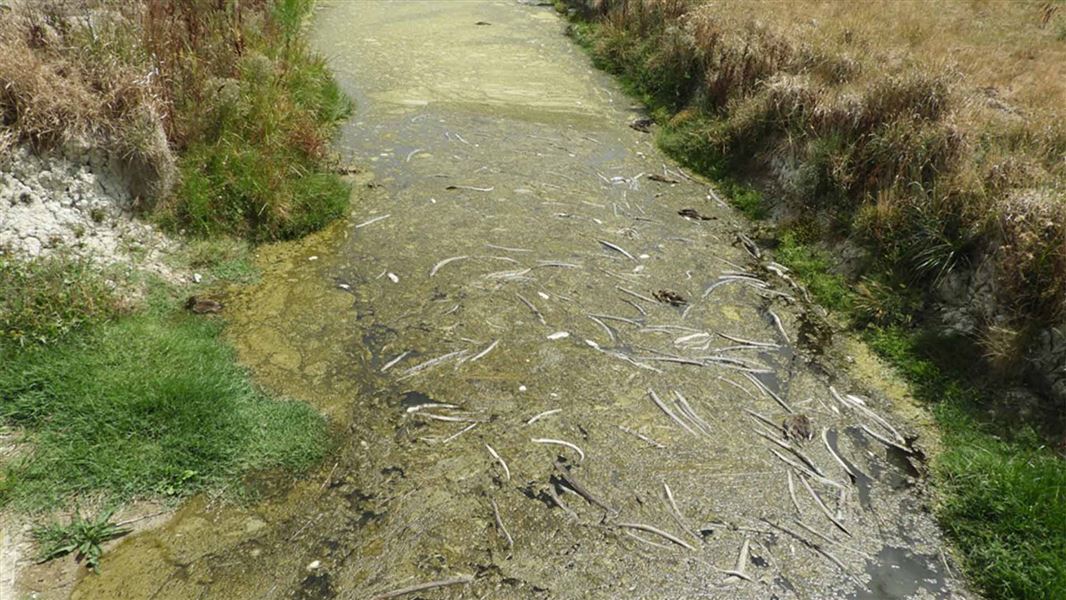Archived content: This media release was accurate on the date of publication.
Date: 02 March 2020
“We are seeing a lot of dead fish in the canals, and birds affected by botulism around the lower Piako River; this is a major concern for the Department of Conservation (DOC) and its partners,” says Mailee Stanbury, DOC Hauraki Senior Biodiversity Ranger.
Ms Stanbury says two internationally significant RAMSAR wetlands - Kopuatai Peat Wetland and the Firth of Thames mudflats - are being put at risk by these two outbreaks.
“The Firth is home to a number of internationally significant migratory wader birds whose numbers are in decline due to worldwide habitat loss – and now, with the combination of the botulism outbreak and the algal bloom, we have a very worrying situation emerging,” she says.
Since January, an outbreak of botulism has resulted in more than 3500 dead birds collected by volunteers involved in a multi-agency clean-up led by Fish & Game New Zealand.
Waikato Regional Council, DOC, local iwi, bird rescue groups, SPCA and duck hunter volunteers have all contributed to the ongoing clean-up. Six teams of hunter volunteers are working around the Firth on an almost daily basis to remove dead birds and minimise the impact of the outbreak.
The local duck population is bearing the brunt of this outbreak, but protected species including shags, spoonbills, herons, harriers, stilts, banded dotterels, and Caspian terns are also affected.
Meanwhile, a Department of Conservation-led response to a suspected toxic algal bloom outbreak affecting birds has seen the rehabilitation and successful release of more than two dozen shorebirds found at Pukorokoro Miranda in the Firth of Thames over the last two weeks.
Pukorokoro Miranda Shorebird Centre staff are still finding a few dead and sick shore birds displaying the same symptoms that led DOC staff to suspect the outbreak of an algal bloom.
Adding to the already dire situation, Fish and Game Auckland-Waikato Gamebird Manager David Klee says dying eels have been trapped in warming drainage channels blocked by floodgates and drying canals along the lower Piako River.
“We measured temperatures of more than 29°C in some of these cut off drains: that’s extreme and much higher than flowing drains and rivers nearby. The fact some of our most pollution-tolerant species such as eels are now dying en masse gives an indication just how bad the situation is there now,” he says.
Mr Klee says degradation of waterways and associated environments, coupled with predictions of longer hotter summers, means these types of botulism and algal bloom outbreaks may become more common.
“It would be unfair to blame these events on temperature alone, however triggers for botulism and the algal bloom outbreak include excessive nutrient loads in streams and canals feeding into the Firth. Human activity has adversely impacted this catchment to the point where its resilience is severely compromised.”
“There is no quick fix and we need all the associated agencies, land users and industries creating and managing discharges to come on board,” Ms Stanbury says.
Some actions that would decrease the likelihood or severity of these incidents occurring in the future include planting shade trees along the northern bank of waterways to lower water temperatures, allowing the tide to naturally flush the various tidal waterways which feed into the Firth, providing fish passages around flood gates, and limiting agricultural and industrial discharges into waterways.
Contact
For media enquiries contact:
Email: media@doc.govt.nz
